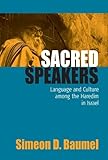Sacred speakers : language and culture among the Haredim in Israel / Simeon D. Baumel.
Material type: TextPublication details: New York ; London : Berghahn, 2006.Description: 1 online resourceContent type:
TextPublication details: New York ; London : Berghahn, 2006.Description: 1 online resourceContent type: - 9781782389323
- 1782389326
- Ultra-Orthodox Jews -- Israel -- Language
- Ultra-Orthodox Jews -- Israel -- Intellectual life
- Language and languages -- Religious aspects -- Judaism
- Hebrew language -- Social aspects -- Israel
- Hebrew language, Talmudic -- Social aspects -- Israel
- Aramaic language -- Social aspects -- Israel
- Yiddish language -- Social aspects -- Israel
- Juifs ultra-orthodoxes -- Israël -- Langage
- Juifs ultra-orthodoxes -- Israël -- Vie intellectuelle
- Langage et langues -- Aspect religieux -- Judaïsme
- Hébreu mishnaïque (Langue) -- Aspect social -- Israël
- Araméen (Langue) -- Aspect social -- Israël
- Yiddish (Langue) -- Aspect social -- Israël
- RELIGION -- Judaism -- General
- RELIGION -- Judaism -- Orthodox
- Hebrew language -- Social aspects
- Language and languages -- Religious aspects -- Judaism
- Yiddish language -- Social aspects
- Israel
- 296.8/32095694 22
- BM390
- online - EBSCO
| Item type | Current library | Call number | URL | Status | Notes | Barcode | |
|---|---|---|---|---|---|---|---|
 eBook
eBook
|
Biblioteca "Angelicum" Pont. Univ. S.Tommaso d'Aquino Nuvola online | online - EBSCO (Browse shelf(Opens below)) | Online access | Not for loan (Accesso limitato) | Accesso per gli utenti autorizzati / Access for authorized users | (ebsco)1215392 |
Browsing Biblioteca "Angelicum" Pont. Univ. S.Tommaso d'Aquino shelves, Shelving location: Nuvola online Close shelf browser (Hides shelf browser)
Sacred speakers; contents; 1. introduction: who are the haredim?; 2. jews and language throughout the ages; 3. historical overview; 4. da'at torah and the public domain; 5. the domestic sphere: language in haredi "space"; 6. educational frameworks; 7. language and culture among sefaradi haredim; 8. language and culture among diaspora haredim: a comparison; 9. conclusions; glossary; bibliography; index.
Despite its outwardly static and traditional appearance, the Haredi (ultra-Orthodox) world is engaged in a constant cultural dialogue with modernity. This dialogue is exceptionally visible in the realm of language as shown in this study that examines the language and culture of four ultra-Orthodox groups found in Israel: the Ashkenazi (European) Mitnagdim-Lithuanians, and the Oriental Sefaradi Haredim. After the presentation of the historical background of the four sects, the author analyzes the public and private domains, focusing on language as used in many different forms and situations, and on the management of language. He furthermore compares the language policies of British, American, and French Haredim belonging to the Habad, Gur, Mitnagdic and Sefaradi sects to those in Israel and finds many similarities between the groups. The book concludes with the proposal of an interdisciplinary model, based on the Haredi case study, which can be used by language planners worldwide to understand the issues of language maintenance and loss among ethnic and ethno-religious minorities.









